The subhorizon photos of 7/8 December show what seems to be part of a diffuse circular halo surrounding the subanthelic point. Similar effect can be simulated with random oriented crystals (arrow in the simulation on the left). It arises from raypaths 3-5-6-7-3 and 3-5-6-7-2-3, which in plate crystals make respectively the Liljequist and sub-Liljequist parhelia.
The simulation on the right provides a 180 degree view of halos from random orientation centered around the subanthelic point. The bright dot is the subanthelion. The narrow small radius halo is from raypath that I have not checked. It seems to disappear if the crystals deviate even a little from regular hexagonal shape. Then there is the diffuse 3-5-6-7-(2)-3 subanthelic halo and blue circle.
Finally, a note on the Parry crystals used in the simulation on the left: no triangles this time, regular h/d 1 hexagons were used. Simulations with Jukka Ruoskanen’s software.

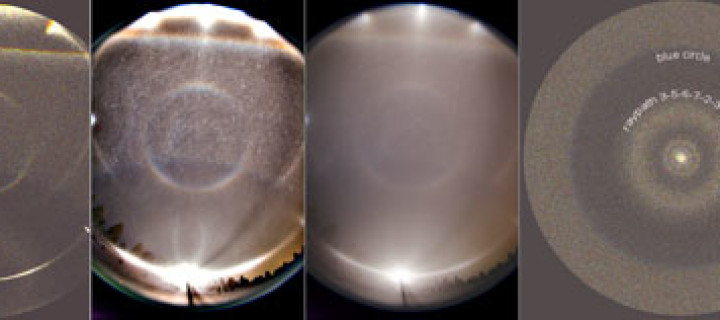

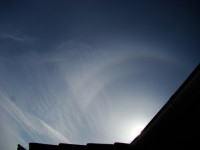
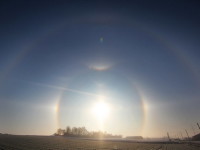
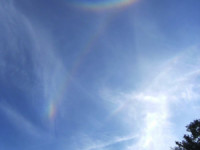
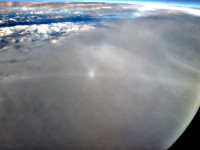
Is it ever going to stop? I happened to think about this halo form when reading one of the last posts (did not notice it in the picture though) and wondered if Marko soon will find something like these weird antisolar halos.
What more undiscovered halo forms are there waiting for being found with lamps?
Nice find.
There is still some more antisolar random crystal stuff to come, and you may actually guess that by looking at the previous post photos. Analysis are still under way.
There was a mistake here. Originally I wrote that this diffuse antisolar halo forms from sub-Lilje raypaths, but now I checked and normal Lilje raypaths contribute as much at least with the h/d 1 crystal that I used. Edited the posting on this.
In simulating this image I used no columns. Only plate, Parry and random populations. In snow guns displays sometimes this happens, but there is one case also from Antarctic diamond dusts by Walt Tape.
And certainly there will be more halos to be discovered with lamp.
Wow that antisolar circular halo is something different. I wonder how many more halos are there going to be in these lamp light displays. Just keeps getting better and better.
I should have used subanthelic halo, because “subanthelic” resonates nicely with helic, subhelic and anthelic. Antisolar breaks the beauty.
Anyway, with these quick blog postings something is always forgotten and I will return to this issue later.
Another halo…good find!
I think have already read something about this halo. I read some time ago an article where people on a boat near the pole witnessed (among many halos) a kind of 22° halo towards the antisolar point…The observers were not halo experts.
I think the halo in my photos is impossible to see in low contrast sun or moon situation. At least sofar we have not been able to photograph “naturally” any of these diffuse intensity areas that are everyday stuff in lamp displays. Fogbow could be an alternative expalanation. Actually Bouguer’s halo will be my next posting topic.
Do you remember the source of the observation?
I was supposed to write my next posting on the broad diffuse circle immediately inside the blue circle (shows up in the left side photos in blue circle posting). It comes up also in simulations, but it does not seem to be an independent halo.